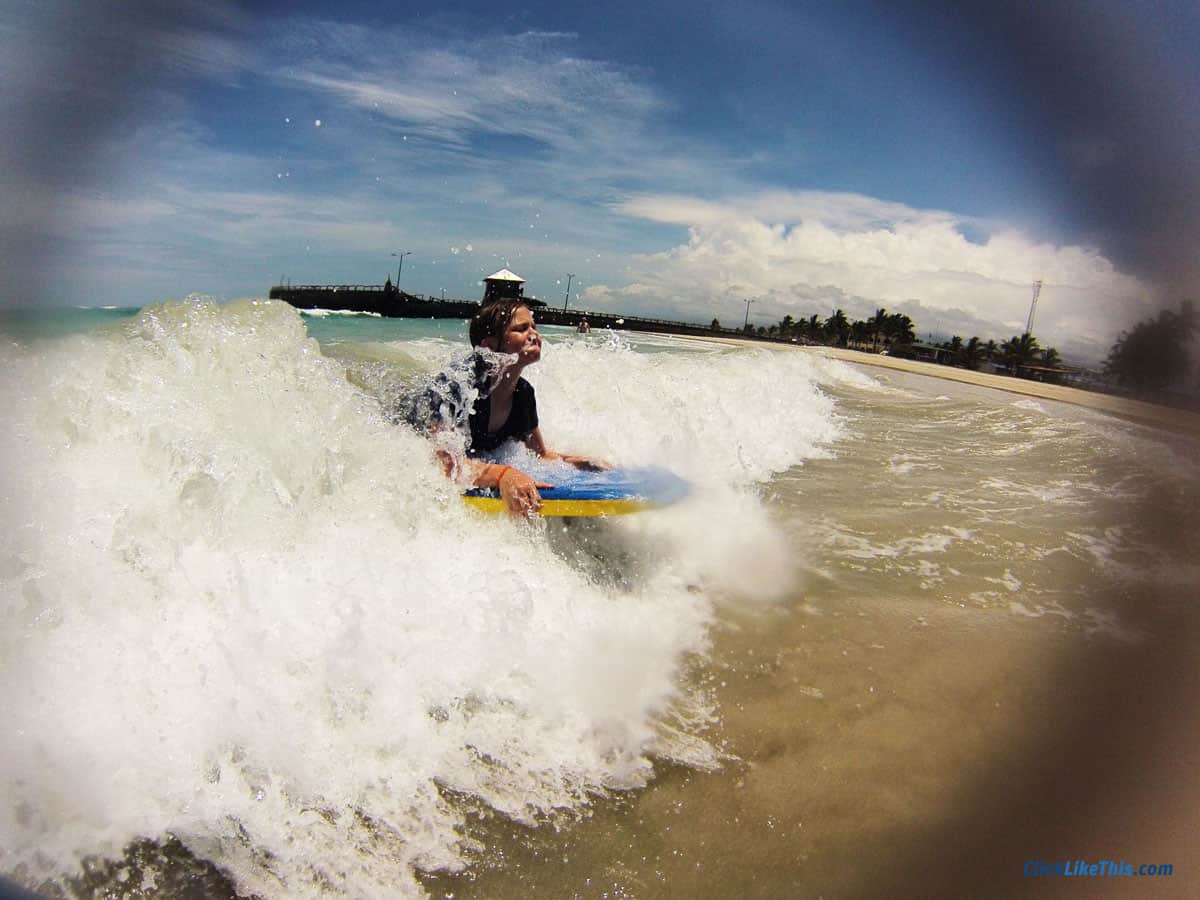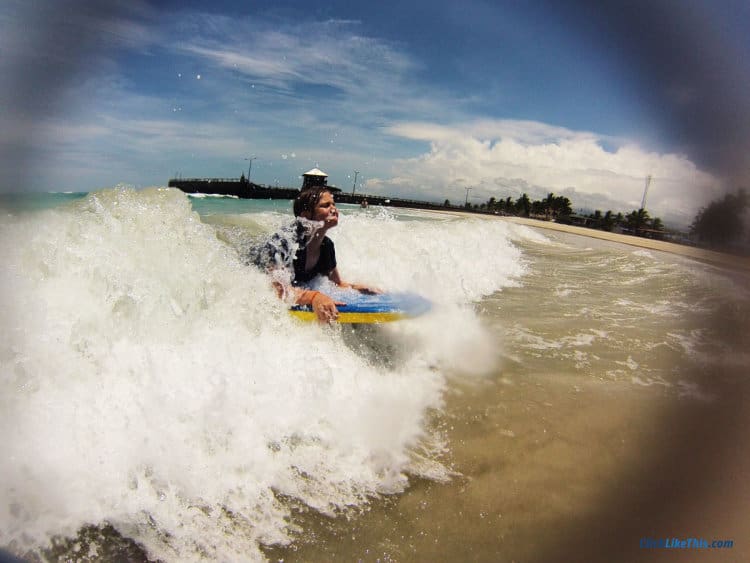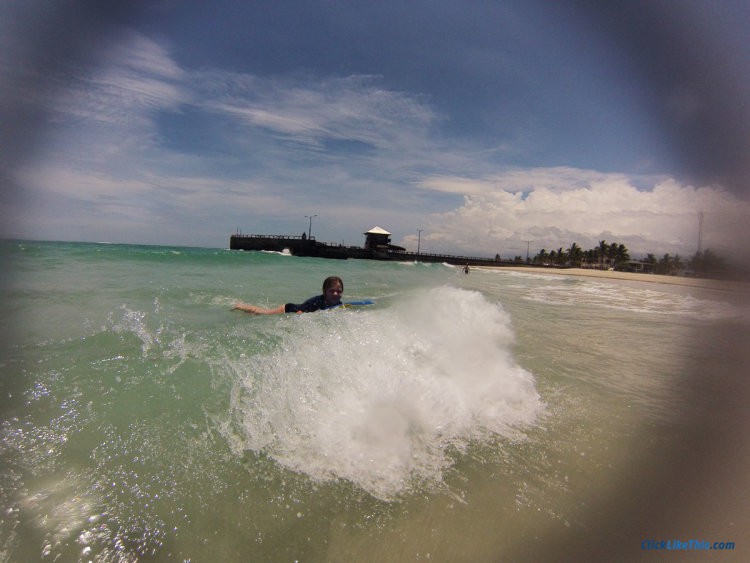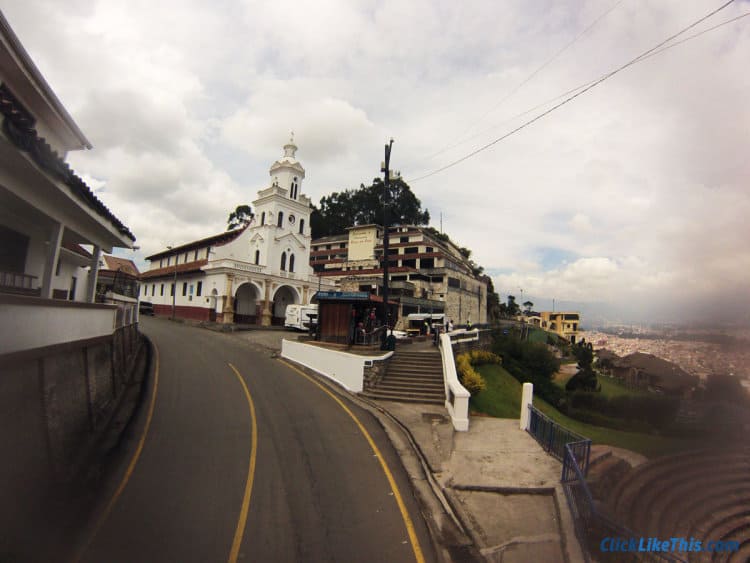In this post, you’ll learn how to eliminate GoPro lens fog. But first, we’ll discover why your GoPro fogs up and also three examples of when moisture can affect the GoPro image quality.

Why Your GoPro Fogs Up
It might sound funny for a waterproof camera to have moisture problems. Why does your GoPro camera fog up?
While the case does a good job of keeping water out, it’s the case itself that causes the problem. Because the case is fully waterproof, any humidity inside of the case is trapped inside.
If the outside air is very cold or if the inside air is very humid, it can cause moisture to condense inside the case.
This problem is most common in water sports (surfing, diving) because of the temperature variance of the air/water and in winter sports because of the variance of inside/outside temperatures.
Even shooting half underwater photos can be affected.
In the following three examples, the waterproof case was working fine – the fog is caused because of the humidity inside the case.
3 Examples of GoPro Lens Fog
1. Galapagos Bodyboarding
On our most recent trip to the Galapagos, I went body-boarding with my daughter. It is one of my favorite memories from these trips.
But as you’ll see in the images below, I had some moisture problems.
As you can see below, the moisture created a black, shadowy halo around the images.



2. Cuenca Bus Tour
When I was shooting the driving time lapse video in Cuenca, the lens began to fog over. The sun was hot, and the camera was mounted on the front of the bus in the open sun.
In the following video, you can see how the fog affects the video quality.
When the bus stopped for a break, I opened the case and wiped out the moisture.

3. Seagull Feeding Frenzy
And while shooting a bit of a feeding frenzy on a beach in Florida, the cold air caused some condensation on the lens. The original video was just over 13 minutes, and the fog didn’t appear until after the 10-minute mark.
The combination of the camera heating up and the cold Daytona Beach afternoon – 8 degrees Celsius (46 degrees Fahrenheit) caused it to fog up.
Here’s what it looked like – the image began to distort, especially on the right side.

So, that’s the problem. How can we fix it?
How to Eliminate GoPro Lens Fog
The simple fix is to add something to absorb the moisture.
If you can take the moisture out of the air, it won’t condense on the lens and affect the shot.
2 Ways to Eliminate GoPro Lens Fog
- Anti-Fog Inserts: These inserts are vacuum-packed and ready to go. Cost: $7-20.
- DIY Inserts (See below): These take a couple of minutes to prepare and won’t absorb as much moisture. They are commonly made with paper towels and occasionally toilet paper. Cost: almost free
The commercially produced anti-fog inserts are made with high-quality silica gel on cellulose fiber. This is the same silica gel that comes in little bags inside many retail goods.
Wikipedia describes silica gel as having “a strong affinity for water molecules.” This means it absorbs the humidity in the air, keeping it off your lens.
These inserts can be dried in an oven and used again.
Which type of anti-fog insert should you use? While I’m a fan of saving money, I don’t favor the DIY insert.
When I’m shooting, I want my images to come out. I spent $600 (Canadian) on my latest GoPro, plus the accessories. I’m not super interested in saving $7 and getting foggy shots.
If your camera gets wet, here’s how to dry your GoPro.
Anti-Fog Inserts for GoPro (2 Options)
Here are your two options for silica-based anti-fog inserts:
- Generic Anti-Fog Insert: CamKix inserts come in a 20-pack. These come vacuum-packed, so they are ready to use out of the package.
- GoPro Anti-Fog Insert: From what I can tell, the anti-fog inserts by GoPro are almost identical to the generic ones – except for the price.
When I got my first GoPro, I shot many videos without inserts. Most of it came out good, but some were ruined by condensed moisture. To eliminate lens fog, make sure you use some type of moisture-absorbing insert.
In this post, you’ll learn how to make DIY GoPro anti-fog inserts.
If you own a GoPro, you have probably seen this problem: Foggy lens and blurry, ruined footage. Why does this happen? Cold, humid, or hot environments can cause moisture to condense on the waterproof housing.
If you want to avoid a foggy GoPro lens, you have two options:
- Purchase GoPro anti-fog inserts
- make your own for free
An anti-fog insert will absorb any moisture that is in the air inside the housing.
More reading: How to use a GoPro underwater
DIY GoPro Anti-Fog Inserts
To make your own DIY GoPro anti-fog inserts, you’ll need:
- a piece of paper towel (the thicker the better)
- a pair of scissors
- Step 1: Cut the paper towel into strips: 3/4″ x 3″ and fold each strip as shown in the photo.
- Step 2: Insert into the camera. You’ll want at least one and up to three anti-fog inserts. I usually use 2-3 to make sure that I don’t get any fog.
See three anti-fog tips below the video.
DIY GoPro Anti-Fog Inserts
Ho Stevie! explains all the details in this 3-minute video.
3 DIY GoPro Anti-Fog Tips
- Check to make sure that the paper towel doesn’t interfere with the gasket on the housing. The last thing you want is the paper towel to wick water into the waterproof housing – or break the seal altogether.
- Pre-cut the strips and store them in a ziplock bag. Have them folded and ready for your adventure.
- Change the inserts each time you change the battery.
Learn more about the capability of your camera in our GoPro Waterproof Guide for all models.
Your Turn
How do you reduce moisture inside your action camera? Please share your tips and challenges below!
- About the Author
- Latest Posts
Hey, I’m Bryan! I’m a content creator and co-founder of Storyteller Tech.
Experienced GoPro Videographer: I’ve been shooting with GoPro cameras for over 11 years. My first GoPro was the Hero3 Silver, bought for a Galapagos work trip in 2012. Today I own 20+ action cameras, including GoPro, DJI, and Insta360 cameras.
Professional Creator: Dena and I have developed video and content marketing plans for numerous international travel brands. And we also run several content businesses.
Bryan also creates at Storyteller.Travel and is co-founder of Storyteller Media, a Canadian-based publishing company.


Veilleur
Saturday 3rd of September 2022
Hey, If you are in a hot humid country and you plan to go for water, diving, surfing ... a good idea is to close the camera protective case in your air-conditioned room and to NOT open it after. The trapped air will be cold and dry which is exactly what you need.